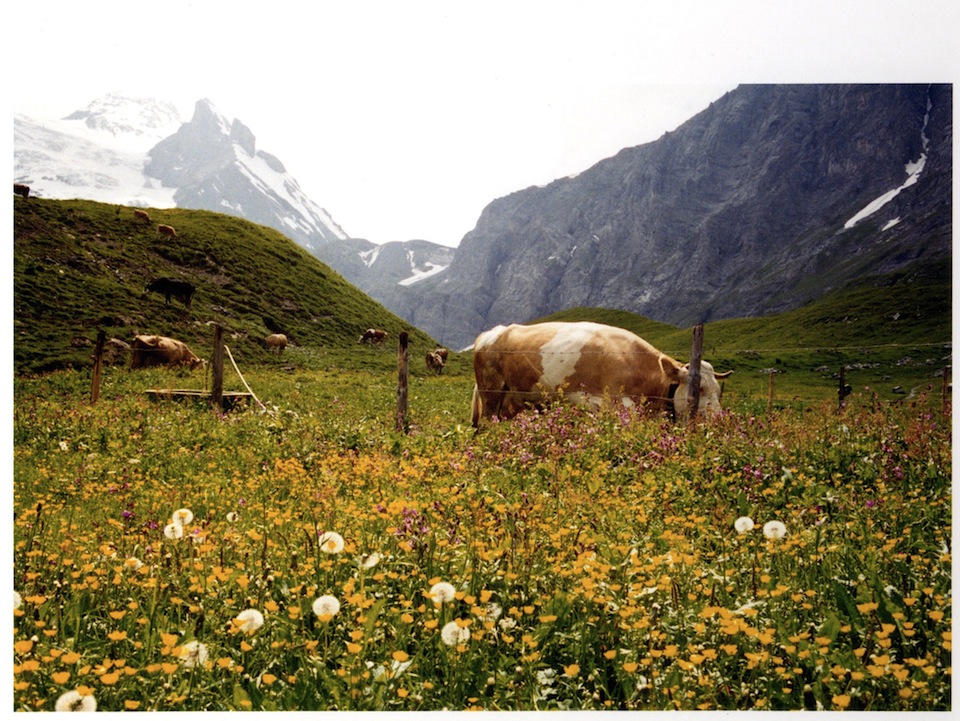
Neither “spa” nor “treatment” comes up in my conversation with Janice, an American living in Switzerland for decades. For the past week, she has been showing me the “real” Switzerland. And I am spellbound. Summertime in this postcard-perfect country is stunning—with its snow-capped mountain peaks, rushing waterfalls, bell-clanking cows, and endless meadows of columbine, daisies, violets, and forget-me-nots. Every morning, we rise early and climb Switzerland’s natural Stairmaster Alps to dark-wooden huts where milk cans hang neatly on pegs alongside giant cowbells, and crisp white laundry beckons in greeting. Not laundry, but cheesecloths.
“You can always tell the huts where they’re making cheese—by the cheesecloths drying on the line,” says Janice, who shares with me the more than 600-year-old tradition.
Every year between June and September, the farmers pack their belongings, scrub their cows and, in a ceremonious send-off (cows are draped with floral headdresses), make their way to the high pastures of the Alps, where the cows feed on 25 to 30 varieties of wildflowers. Once settled into their modest, Heidi-esque huts—simple wooden table and chairs, sleep mattresses in an upstairs loft—the farmers go to work. There is no electricity—a generator supplies the power needed for morning and afternoon milking.
“We love it here,” says one farmer, in halting English. “In the morning and evening, when the generator is running, we listen to the radio and charge our cell phone. And in nice weather, people, like you, come up to visit.”
During the late 1800s, as tourists began coming to Switzerland to drink whey (for health), grand hotels began adding whey baths as a skin-softening beauty regimen. In time, however, the whey bath faded, giving rise to more glamorous spa treatments . . .
After milking the cows, the fresh milk is poured directly into a giant copper cauldron and heated over an open fire. Rennet, an enzyme found in the stomach lining of calves reared solely on milk, is added to help “curdle” the milk, as is bacteria culture to help ferment and age the cheese. As the whey (liquid) begins to separate itself from the cheese mass, the cauldron is removed from the fire by a heavy wooden swing handle, which is stirred for up to 45 minutes before returning to the fire.
And it is at this stage—during the separating of the curds and whey—that Janice smiles, pointing to the bag containing the bathing suit she instructed me to bring. “You may want to put that on.”
As I change quickly (in a cow stall), I emerge to find the farmer—using a muslin cheesecloth, dipping both arms into the copper pot, scooping out the cheese (which at this stage looks more like cottage cheese) and leaving the whey behind. His wife moves in quickly behind him, pouring the hot whey into mugs.
“Is goot,” the farmer says, raising his mug. “Please, have some.”
For centuries, Swiss farmers have sworn by the holistic health attributes of whey, attributing it to longevity. I take the steaming mug, and gingerly sip the warm, sourish milk taste—and I’m not enamored. Janice, sensing my polite dislike, just smiles. “Come. You’ll like this better.”
I follow her outside where the farmer, via a hose leading to the copper cauldron, is slowly filling a large wooden cask with whey. As the tub fills with the soft yellow liquid, he discreetly disappears, and I climb into the foamy, velvety texture—deliciously warm. Surprisingly, the bath is not sticky, but rather smooth and lightly fragrant, with the gorgeous scent of wildflowers. For the next 30 minutes, I soak gloriously in the warm liquid, savoring the fresh mountain air and gentle clanking of cowbells, as Janice shares the history of this whey-out bath. During the late 1800s, as tourists began coming to Switzerland to drink whey (for health), grand hotels began adding whey baths as a skin-softening beauty regimen. In time, however, the whey bath faded, giving rise to more glamorous spa treatments. Too bad—because as I emerge from this yellow-velvet liquid my skin is supple, soft; my mind, beyond relaxed.
After changing once again—this time in the presence of a bell-clanking cow named Anemone—I’m greeted by the farmer, who sends me off into the alpine meadows, with a wheel of his prized cave-aged cheese as remembrance.
Editor’s Note: According to Switzerland Tourism, there are organized whey bath offerings on Engelberg Alp (in front of the Gerschni Alpine Hut) and in Berglialp, in the Glarus Region. For information, contact myswitzerland.com.
Shari Mycek
A longtime luxury travel and spa writer, Shari Mycek has traveled to more than 65 countries in search of the most authentic healing modalities. She is published in national and international magazines including Conde Nast Traveler and Conde Nast Traveller UK,